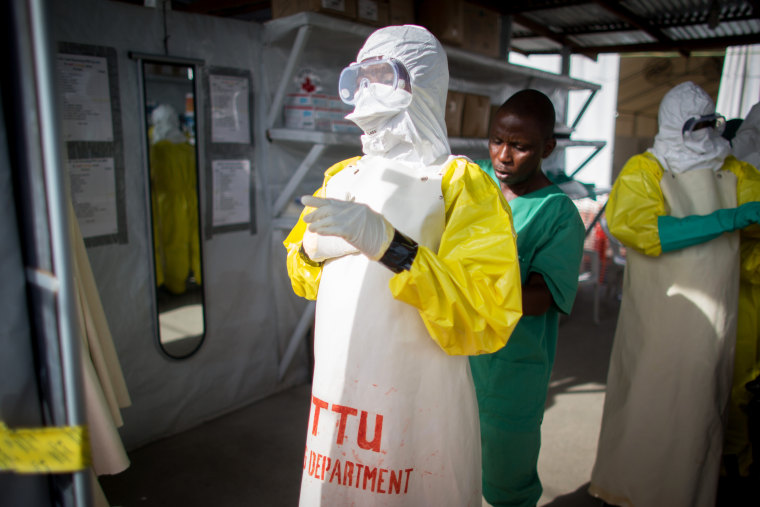A New Jersey man who had recently traveled to Liberia died on Monday from Lassa, a hemorrhagic fever with some similarities to Ebola. In a few eerie echoes of the Ebola infections that captured the nation’s attention this past summer, the man flew through JFK airport in New York. He was also sent home after his first visit to the hospital, when he was asked for his travel history but declined to mention he had visited West Africa.
Unlike Ebola, however,“there has never been person-to-person transmission of Lassa fever documented in the United States,” the Centers for Disease Control (CDC) said in a statement Monday. “The New Jersey case is the sixth known occurrence of Lassa fever in travelers returning to the United States since 1969, not including convalescent patients. The last case was reported in Minnesota in 2014."
It’s worth noting that average Americans are unlikely to be infected by either Lassa or Ebola — and that there are no U.S. travel bans in place for the West African countries most affected by the disease. Nonetheless, here’s breakdown of how the two terrifying diseases are similar, and how they're different.
Symptoms
Both Lassa and Ebola are hemorrhagic fevers with symptoms that include fever, headache, muscle pain, weakness, fatigue and vomiting. These symptoms tend to be more severe in Ebola cases. In severe cases, both diseases can cause bleeding from the gums, eyes and nose, for instance. That awfulness can then lead to organ failure and death, as in the case of the New Jersey man who died Monday.
Lassa, as opposed to Ebola, can also cause tremors, facial swelling, respiratory distress and encephalitis in serious cases. A horrific bonus fact about Lassa: It can cause varying degrees of deafness in mild and severe cases — oftentimes, the hearing loss is permanent. This happens in about one-third of infections, according to the CDC.
Infection
Here’s the relative less-bad news about Lassa: Only about 20% of cases become severe, while 80% remain mild, meaning they’re often undiagnosed. Symptoms of infection for the disease appear between six and 21 days and usually begin gradually.
With Ebola, symptoms generally appear between eight and 10 days after infection, but can surface between two and 21 days after infection. That’s why the milestone for declaring a country Ebola-free is 42 days, or twice the longest incubation period.
RELATED: Liberia deemed Ebola-free
Transmission
Lassa fever is spread by rodents, which carry the virus in their excrement and urine, sometimes for the rest of their lifespan. Their waste either contaminates food directly or infection can be caused by contact with it. The virus can become airborne when the excrement dries and is then swept up into dust, for instance. Then people breathe it in. Lassa fever’s transmission is similar to that of Hantavirus, which killed several young adults in the American Southwest in 1993.
Infection can also occur when humans eat the infected rodents.
“In rare cases [Lassa] can be transmitted from person to person through direct contact with a sick person’s blood or bodily fluids, through mucous membrane, or through sexual contact,” the CDC said in Monday’s statement.
While Ebola also has animal hosts — the World Health Organization believes that fruit bats likely infect other animals like chimpanzees and gorillas — it is primarily spread among humans through contact with bodily fluids. The most infectious substances are blood, feces and vomit.
With both Ebola and Lassa, person-to-person infection often occurs in health care settings via bodily fluids and through improper protection. In addition, patients are not believed to be infectious unless they are showing symptoms. Recall the New York City doctor who came back and socialized with friends and family without infecting them.
RELATED: Craig Spencer declared Ebola-free, to be released from Bellevue
The West African countries hardest hit by Ebola infections also harbor Lassa fever: Liberia, Sierra Leone, Guinea. Lassa also occurs in parts of Nigeria.
Fatalities
Both diseases have triggered epidemics, though fatality rates are different: In Lassa epidemics, death rates can be as high as 50%, while Ebola has claimed as many as 90% of those infected during particularly severe outbreaks.
Only 1% of all Lassa virus infections overall are fatal. But 15% to 20% of those treated for the disease in hospitals — presumably these are the most severe cases — die. The disease is particularly deadly for women with late-term pregnancies. Spontaneous abortion can occur and there is “an estimated 95% mortality in fetuses of infected pregnant mothers,” according to the CDC.
Overall, those infected with Ebola die in 50% of cases, whereas those who do not receive treatment exhibit a 70% fatality rate.
Treatment
Lassa infections are treated with the drug Ribavirin. Ebola, on the other hand, does not yet have an FDA-approved drug used for treatment. Clinical trials have begun for possible vaccines to prevent Ebola infections, though.
